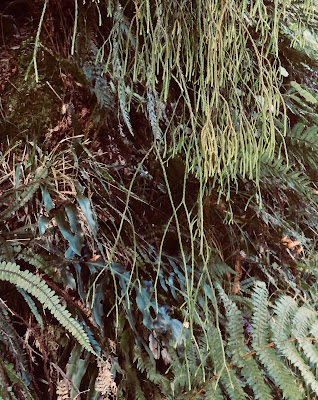Here's a beauty to look out for on the tramping trail. In the forest it grows as an epiphyte (it's a plant that grows on trees) and in our mixed podocarp/broadleaf forests can sometimes be seen at eye-level. That's perfect for spotting while walking along!
 |
| Hanging club moss in forest near Paraparaumu |
Look closely and you'll notice something quite amazing. They sprout out all straggly to start with ..
 |
| Hanging clubmoss Akatarawa forest, Wellington |
 |
| Hanging clubmoss in Tararua Forest Park |
 |
| Detail from a large hanging clubmoss Whanganui National Park |
 |
| Mature clubmoss, photo Catherine Kirby |
 |
| Some grow to be more than a metre long. Hanging clubmoss Whanganui National Park |
Looking for the little things
Lately I've been reading different points of view about the impact of naming big trees, publishing 'Top 10 Things to See" lists and Instagram shots of unique places. On one side named trees, must-see lists and unique places aid tourism and create an interest in experiencing nature. On the other these named places can such experience high visitor numbers that they destroy the very thing people have come to look at.
Like many other kiwis I've been to see Tāne Mahuta, the giant kauri. Afterwards I wrote a blog about it and the kauri dieback problem. I hope my blog made a few more people aware of the problem, but it may have enticed just as many to go and take a look.
Thinking about this and what pictures I post on my Instagram, I've resolved to focus on the little things that people can see in many places out in the bush or at the beach.
Rather than ticking off a list of must-see places, let's look for and appreciate the small wonders all around us.Further reading
Field Guide to New Zealand's Epiphytes, Vines & Mistletoes by Catherine L. Kirby is a great guide to satisfy curious minds
No comments:
Post a Comment